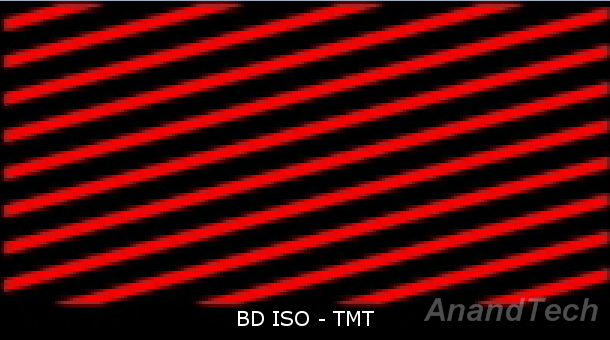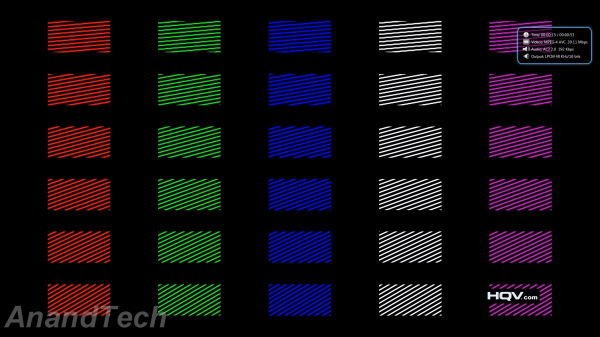AMD Radeon HD 7750 & Radeon HD 7770 GHz Edition Review: Evading The Price/Performance Curve
by Ryan Smith & Ganesh T S on February 15, 2012 12:01 AM EST- Posted in
- GPUs
- AMD
- HTPC
- GCN
- Radeon HD 7000
HQV 2.0 Benchmarking
HTPC enthusiasts are often concerned about the quality of pictures output by the system. While this is a very subjective metric, we have decided to take as much of an objective approach as possible. Over the last year or so, we have been using the HQV 2.0 benchmark for this purpose.
The HQV 2.0 test suite consists of 39 different streams divided into 4 different classes. The playback device is assigned scores for each, depending on how well it plays the stream. Each test was repeated multiple times to ensure that the correct score was assigned. The scoring details are available in the testing guide on the HQV website.
We first played back the benchmarking clips off the Blu-ray, but the scores recorded below are for standalone M2TS playback using CyberLink PowerDVD 12. Our take is that it is standalone files (such as those taken using consumer camcorders and smartphones) which require video post processing more than the already carefully transferred Blu-ray content. If certain driver post processing features are available only for Blu-ray playback, then, it is as good as not being available for consumers to take advantage.
In the table below, we indicate the maximum score possible for each test, and how much the 7750 was able to get with AMD's Catalyst 12.1-based launch drivers.
| AMD 7750 : HQV 2.0 Benchmark | ||||
| Test Class | Chapter | Tests | Max. Score | Radeon HD 7750 |
| Video Conversion | Video Resolution | Dial | 5 | 5 |
| Dial with Static Pattern | 5 | 5 | ||
| Gray Bars | 5 | 5 | ||
| Violin | 5 | 5 | ||
| Film Resolution | Stadium 2:2 | 5 | 5 | |
| Stadium 3:2 | 5 | 5 | ||
| Overlay On Film | Horizontal Text Scroll | 5 | 5 | |
| Vertical Text Scroll | 5 | 5 | ||
| Cadence Response Time | Transition to 3:2 Lock | 5 | 5 | |
| Transition to 2:2 Lock | 5 | 5 | ||
| Multi-Cadence | 2:2:2:4 24 FPS DVCam Video | 5 | 5 | |
| 2:3:3:2 24 FPS DVCam Video | 5 | 5 | ||
| 3:2:3:2:2 24 FPS Vari-Speed | 5 | 5 | ||
| 5:5 12 FPS Animation | 5 | 5 | ||
| 6:4 12 FPS Animation | 5 | 5 | ||
| 8:7 8 FPS Animation | 5 | 5 | ||
| Color Upsampling Errors | Interlace Chroma Problem (ICP) | 5 | 2 | |
| Chroma Upsampling Error (CUE) | 5 | 2 | ||
| Noise and Artifact Reduction | Random Noise | SailBoat | 5 | 5 |
| Flower | 5 | 5 | ||
| Sunrise | 5 | 5 | ||
| Harbour Night | 5 | 5 | ||
| Compression Artifacts | Scrolling Text | 5 | 5 | |
| Roller Coaster | 5 | 5 | ||
| Ferris Wheel | 5 | 5 | ||
| Bridge Traffic | 5 | 5 | ||
| Upscaled Compression Artifacts | Text Pattern | 5 | 3 | |
| Roller Coaster | 5 | 3 | ||
| Ferris Wheel | 5 | 3 | ||
| Bridge Traffic | 5 | 3 | ||
| Image Scaling and Enhancements | Scaling and Filtering | Luminance Frequency Bands | 5 | 5 |
| Chrominance Frequency Bands | 5 | 5 | ||
| Vanishing Text | 5 | 5 | ||
| Resolution Enhancement | Brook, Mountain, Flower, Hair, Wood | 15 | 15 | |
| Video Conversion | Contrast Enhancement | Theme Park | 5 | 5 |
| Driftwood | 5 | 5 | ||
| Beach at Dusk | 5 | 5 | ||
| White and Black Cats | 5 | 5 | ||
| Skin Tone Correction | Skin Tones | 10 | 7 | |
| Total Score | 210 | 193 | ||
We were not able to match what AMD claimed. In all probability, the difference is in the chroma upsampling scores. We already covered this in the Llano review. To recap, the image below is a screen capture while playing the HQV benchmark clip from a Blu-ray ISO on the AMD A8-3850. Note that the light red fringes along the edgs are uniform and extend to the right and the left before tapering off.

Now, let us look at the screen capture when the M2TS is played back using PowerDVD 12 on the Radeon HD 7750.
Zoom into the red stripes on the third row (in the original screenshot) and you can see for yourself that we have some ghost samples extending above and below the actual line of pixels. The screenshot is not at the exact timestamp as that of the Llano sample reproduced above, but the reader should be able to get a general idea of the problem we are hinting at. Readers interested in finding out more about the source of this problem should read up this excellent piece to get more information.
We notified AMD about this issue during the Llano review, but action doesn't seem to have been taken even after 6 months on what is clearly a driver issue. Note that we are not using MPC-HC (which might introduce its own errors in the renderer) in this case, but a standard off-the-shelf commercial player in CyberLink PowerDVD 12. Hopefully, AMD wakes up to this issue soon.











155 Comments
View All Comments
mattgmann - Wednesday, February 15, 2012 - link
Don't forget, when the 4870 pricing was low, at the end of 2008, BOTH AMD and Nvidia were settling price fixing lawsuits. These companies have cheated before; they'll do it again.Hubb1e - Wednesday, February 15, 2012 - link
"Recessions are good for the rich... not so good for everyone else. "Really? So when the stock market lost 40% of its value and the rich lost 40% of their net worth, that was good for them?
The rich can ride out a recession better than the poor because they don't live paycheck to paycheck, but it sure as hell wasn't good for them.
Galidou - Sunday, February 19, 2012 - link
Maybe we can see 4870's with maximum performance/die size in mind pricing failure because it was performing close to the big die from Nvidia gtx2xx. Or maybe we can see the ''double performance from last gen'' tactic from Nvidia a fail when it means building a super big die with low performance/size ratio just to get that double performance motto... It was all a question of ''goal to attain'' from each company. One goal paid off more than the other that time.From an Nvidia's fanboy perception, the first will be true and the second unthinkable. From an ATI fanboy, the first will make no sense and the second will suit them well. From someone with no choosen side, both can be true.
But these 7770 and 7750 here, makes no sense, such small die with such performance for that price.....
Malih - Wednesday, February 15, 2012 - link
I agree, smells fishy, usually at this point nVidia would lower their card price.The latest price competitive part from AMD is the 6800 series. Probably have to wait for the 8800 series?
Kjella - Wednesday, February 15, 2012 - link
I know, I bought a 5850 before the MSRP hike for around $279 + VAT in 2009 and I just checked, it clearly beats a 7770 so a >$159 value today, maybe close to the $200 card being launched in March. The 6xxxx series I thought was just because they had to scrap the 34nm process and deliver essentially a refined 5xxx series, but now they're on 28nm and there's not much bang for the buck for those of us that already have a gaming card from the 4/5xxxx series. I hope this is just a temporary situation until nVidia gets their Kepler out, or I might just sit out another generation...eminus - Wednesday, February 15, 2012 - link
AMD has AMD (Accute Money Deficiency) right now so they need every penny they can gain.Cygni - Wednesday, February 15, 2012 - link
It seriously seems that the 4850/4870 was an incredible purchase. In 2009, you could get a 4850 for $99 dollars. And it STILL holds up to the top range cards.I mean we all know that Nvidia and AMD are playing the profit game 10 times harder than the performance game in this sector, simply because games can't press the limits of the hardware, but it's still impressive.
just4U - Wednesday, February 15, 2012 - link
I bought 4 cards in the 4x lineup..First a 4850 for $170, Second a 4870 for $199 Third a 4870 1G for $229 and lastly a 4830 for 140.. While I live in Canada I don't think prices ever came that low unless you got one helluva good deal.. $99 pricing for the 4850 wasn't the norm even late in its production run.
BPB - Wednesday, February 15, 2012 - link
I got mine real chaep at launch! BestBuy mispriced them. Still, not too much later there were good deals again and I got one for my daughter's desktop. These cards in CF still hold up well for 1920x1200 gaming. I would like to upgrade to better performance and lower power, but AMD is making that hard dollar-wise.Jorgisven - Wednesday, February 15, 2012 - link
Indeed. Best Buy had a 25% off all Visiontek cards the week of the 4850 launch, so I got mine at launch for $150. I then caught an amazing deal on a 4870 a few months later ($129 shipped), sold my 4850 for $140. I basically bought both for a net $140.I've been waiting for a good AMD card, but just haven't seen one. I've been tempted by the 560 Ti or 570, but they're still too expensive for my taste, and don't offer enough of an advantage to spend the cost of a PS3 on upgrading from an already decent GPU.
I'm rather disappointed with Red as of late.